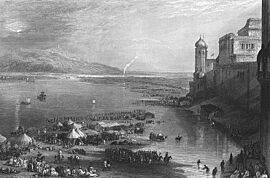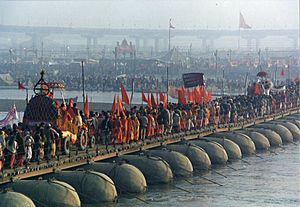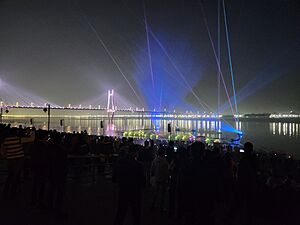Prayag Kumbh Mela facts for kids
Quick facts for kids Prayag Kumbh Mela |
|
|---|---|
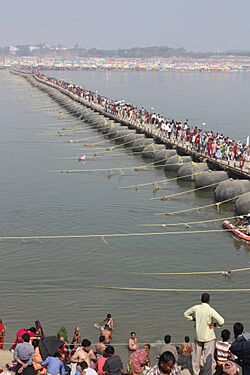
2013 Maha Kumbh Mela
|
|
| Status | Active |
| Genre | Fair |
| Frequency | Every 12 years |
| Venue | Triveni Sangam |
| Location(s) | Prayagraj, Uttar Pradesh |
| Coordinates | 25°25′52″N 81°53′06″E / 25.431°N 81.885°E |
| Country | India |
| Previous event | 2025 (Purn Kumbh / Maha Kumbh Mela) |
| Next event | 2031 (Ardh Kumbh Mela) |
| Participants | Akharas, pilgrims and merchants |
| Budget | est. ₹4,200 crores |
| Activity | Rituals |
| Organised by | Prayag Mela Authority |
| Sponsor | East India Company until 1857; British Raj until 1947; thereafter Government of India. |
The Prayag Kumbh Mela, also known as Allahabad Kumbh Mela, is a huge religious gathering for people who follow Hinduism. It takes place in the city of Prayagraj, India. This special event happens at the Triveni Sangam, which is where three important rivers meet: the Ganges, the Yamuna, and the mythical Sarasvati river.
The main part of the festival is a ritual bath in the holy waters. But it's also a big celebration! There are many fairs, educational talks, religious speeches by saints, and large meals for monks and people in need. It's a truly amazing sight.
The Prayag Kumbh Mela is known as one of the largest peaceful gatherings in the world. For example, the Ardh Kumbh Mela in 2019 had about 50 million people. The Maha Kumbh Mela in 2013 saw around 30 million people bathing in the holy river Ganges. The 2025 Maha Kumbh Mela is currently taking place.
A full Kumbh Mela happens every 12 years. A smaller version, called an Ardh (half) Mela, takes place about every 6 years at the same spot. The exact dates are decided using the Hindu luni-solar calendar. This depends on the positions of planets like Jupiter and the Sun and Moon in certain zodiac signs.
The Mela is one of four main Kumbh Melas. An annual fair, called Magh Mela, has been held at the Triveni Sangam in Prayagraj for a very long time. Ancient texts like the Puranas and the Mahabharata mention this site and its sacredness. However, the name "Kumbh Mela" for the bathing festival at Prayagraj only started being used after the mid-1800s.
Contents
When the Mela Happens
The Kumbh Mela in Prayagraj usually takes place in the month of Magh. This is when Jupiter is in Aries, and the Sun and Moon are in Capricorn. Sometimes, these astrological positions don't perfectly match the month of Magh, but the Mela still happens then. For example, the 1989 Kumbh Mela started in January, even though the stars suggested a later date.
Sometimes, Hindu astrologers have different ideas about the exact conditions for a Mela. This has led to fairs being called Kumbh Melas in back-to-back years, like in 1941 and 1942, or 1965 and 1966 in Prayagraj.
History of the Mela
Hindu stories say that the god Vishnu accidentally dropped drops of amrita (a drink that gives immortality) from a kumbha (pot) at four places. Prayagraj is one of these four places, which are now the sites of the Kumbh Mela. The river-side fair at Prayagraj is very old. But its connection to this kumbha story and the 12-year cycle became popular in the 1800s. Priests in Prayagraj adopted these ideas from the Haridwar Kumbh Mela and added them to their local Magh Mela, which was an annual event.
Early Records of the Magh Mela
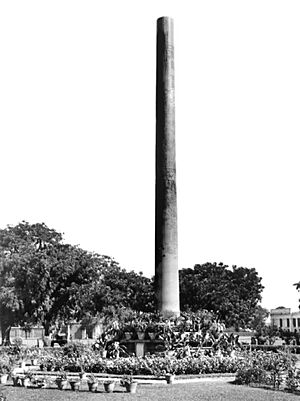
The Chinese traveler Xuanzang wrote about a possible early version of this fair in 644 CE. He mentioned that Emperor Harsha would give away his wealth every five years at a place where two rivers met. Many people would bathe there to wash away their sins. Some scholars think this is the earliest record of the Kumbh Mela or a similar event. However, some researchers note that Xuanzang's account describes an event every 5 years, not 12, and might have been a Buddhist festival.
Some groups, like the akharas (groups of Hindu monks), believe that Adi Shankara started the Kumbh Mela in Prayagraj in the 700s. This was supposedly to help holy men from different areas meet. But many experts question if this is true.
There are no records of a Kumbh Mela with a 12-year cycle in Prayagraj before the 1800s. Old texts like the Matsya Purana talk about how holy Prayagraj is in the Magha month, but they don't mention a "Kumbh Mela." Other historical writings from the 1500s and 1600s, like Chaitanya Charitamrita and Ramcharitmanas, describe the Mela in Prayagraj as an annual event, not one that happens every 12 years.
Even British records from the 1700s and early 1800s, which were very detailed for tax reasons, describe the Magh Mela as an annual event. They don't call it "Kumbh" or mention any special importance for a Mela held every 12th year. This is different from how they described the Haridwar Kumbh Mela, which they did call "Kumbh" and noted its 12-year cycle.
How the Magh Mela Became the Kumbh Mela
It's hard to say exactly when the Magh Mela started being called a Kumbh Mela. The fair in Prayagraj in 1870 is the first one that was clearly called a "Kumbh Mela" by people at the time. The Kumbh Mela that should have happened in 1858 didn't take place because of the 1857 uprising.
In 1868, a British official named G. H. M. Ricketts wrote about the need for better sanitation at the "Coomb fair" (Kumbh Mela) planned for 1870. He also mentioned seeing a huge crowd at an "Ad Coomb" (Ardh Kumbh) four years earlier. Another official, J. C. Robertson, also called the 1870 fair a "Koombh." This report is also the first to mention a special procession of sadhus (holy men) at Prayagraj, which only happens during a Kumbh Mela.
Some historians believe the 1870 Mela was the first to be called a "Kumbh Mela" in Prayagraj. The local priests, called Prayagwals, earned money from the Magh Mela. When the British tried to tax pilgrims heavily, it caused problems. Even after the British stopped taxing pilgrims in 1840, they still taxed traders. It seems the Prayagwals adopted the "Kumbh" name and stories from Haridwar for their ancient annual Magh Mela around this time. This helped them deal with the changing times in the 1800s.
Challenges During British Rule
During the British rule, the Prayagwals and other Hindus were not happy about Christian missionaries being present at the Mela. These missionaries, supported by the government, tried to convert Hindu pilgrims. They gave out materials that criticized Hindu practices and beliefs.
The Prayagwals argued that Hindus were not allowed to do the same things in Christian places. They felt this was unfair. Even though the missionaries tried hard, they didn't have much success in converting Hindus at the Kumbh Melas. However, this situation led to Hindu-owned printing presses starting up. These presses began publishing and sharing materials that supported the Kumbh Mela, Hindu beliefs, and were against colonial rule.
The British government also accused the Prayagwals of helping to cause the 1857 uprising in Prayagraj. After the rebellion, the British punished the Prayagwals. They even destroyed the area where the Prayagwals lived near the Mela site. The British also took over large parts of the Kumbh Mela land. In the years after 1857, pilgrims at the Kumbh Mela sometimes carried flags that hinted at the rebellion and unfair treatment.
Kumbh Mela Under British Rule
From the mid-1800s, better roads and railway networks made it easier for pilgrims to travel. However, the number of people attending changed a lot over time. It's hard to get exact numbers from history. For example, some old British reports said 2 to 2.5 million people attended in 1796 and 1808, but they also said these numbers might be too high. Between 1892 and 1908, during times of famine and disease, attendance dropped to 300,000 to 400,000.
The British government started collecting taxes and managing the Mela services from the 1860s. They allowed missionaries to set up camps and gave official licenses for "gambling carnivals." Hindus were unhappy about these things. They asked for Hindu officials to manage the festival instead of Muslim officials. Over time, feelings grew stronger, and the Kumbh Mela became a place to promote Hindu interests. However, the festival itself remained peaceful and did not see Hindu-Muslim violence.
Notable Events During British Rule
- Kumbh Mela, 1882: A Muslim manager was appointed for the Mela. Some Indian newspapers reported that he organized parties for Europeans, which included dancing girls and alcohol, while pilgrims were bathing. This caused a scandal.
- Ardha Kumbh Mela, 1888: A Christian missionary asked the government not to be involved in the Mela, saying it supported "idolatry." But the British officials refused, saying their involvement was needed to control the armed Sadhus.
- Kumbh Mela, 1894: According to Paramahansa Yogananda's book Autobiography of a Yogi, it was at this Mela that his teacher Sri Yukteswar met Mahavatar Babaji.
- Kumbh Mela, 1906: There was a fight between two groups of Naga Sadhus. The police had to use cavalry (soldiers on horseback) to break it up.
- Kumbh Mela, 1942: The government banned the sale of train tickets to Prayagraj for a month in 1941. This was because Japan had entered World War II, and the government wanted to keep the number of attendees low due to rumors of a bombing. Also, a group of monks asked the government to ban non-Hindus (like Muslim police and Christian missionaries) and gambling at the Mela.
Many villagers who had recently become wealthy started attending the Mela as a sign of their status. They would record their family histories in the registers kept by the Prayagwals. They also recorded their land ownership claims, which could be used in court if there were disputes.
Kumbh Mela in Independent India
Kumbh Mela, 1954
A terrible stampede happened on February 3, 1954. Around 800 people lost their lives. About 5 million pilgrims had visited the festival that year.
Ardh Kumbh Mela, 2007
More than 70 million people visited the Ardh Kumbh Mela over 45 days.
Kumbh Mela, 2013
An estimated 120 million people visited the Maha Kumbh Mela in 2013 in Prayagraj over two months. On one single day, February 10, 2013 (the day of Mauni Amavasya), over 30 million people gathered. This festival was one of the first large gatherings to use cloud-based systems to track diseases in almost real-time.
Prayagraj Kumbh 2019
In December 2017, UNESCO recognized the Kumbh Mela as an "intangible cultural heritage of humanity." The Chief Minister of Uttar Pradesh, Yogi Adityanath, announced that the "Ardh Kumbh" would be renamed simply "Kumbh." A new law was passed to set up the Prayagraj Mela Authority and make this name change official.
The state government spent about ₹2,500 crore for the Ardh Kumbh 2019. This was more than double the amount spent on the 2013 Kumbh. Many projects were completed, including a six-lane bridge over the Ganges and a four-lane railway bridge. Money was also spent on clean drinking water, electricity for the Mela area, and managing waste to keep the Ganges clean. Roads were also widened and beautified.
Prayag Maha Kumbh Mela 2025
The 2025 Maha Kumbh is the current Maha Kumbh Mela. It started on January 13, 2025, and is scheduled to continue until February 26, 2025. It is taking place at the Triveni Sangam in Prayagraj, Uttar Pradesh, India.
Stampedes at the Mela
Sadly, there have been several stampedes at the Prayag Kumbh Mela over the years. These include incidents in 1840, 1906, 1954, 1986, 2013, and 2025. The deadliest one was in 1954, where 800 people died.


